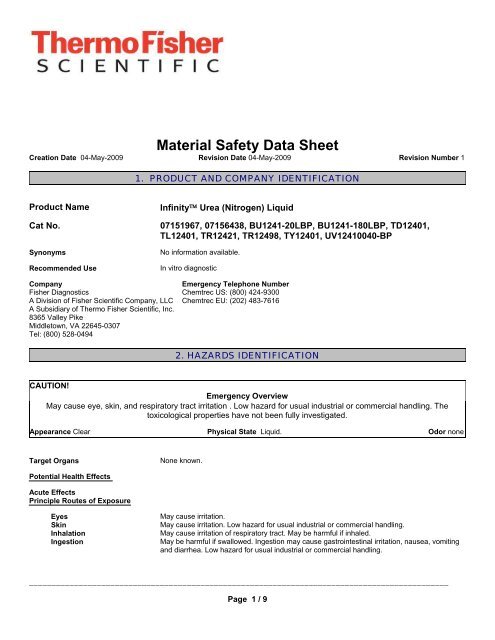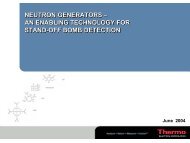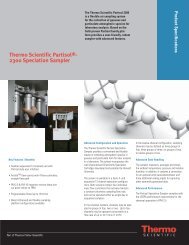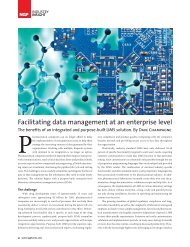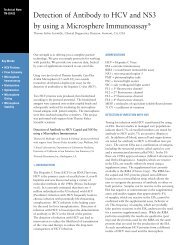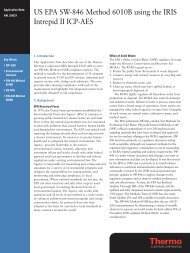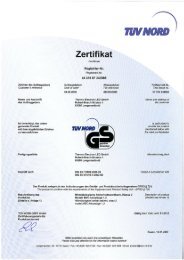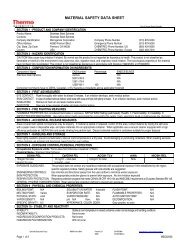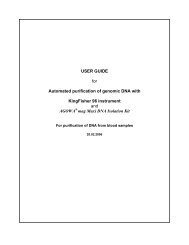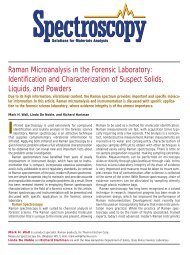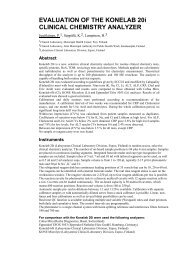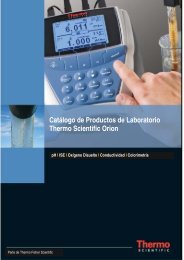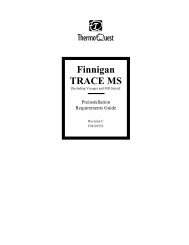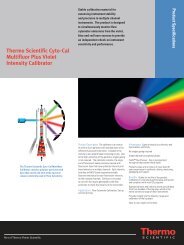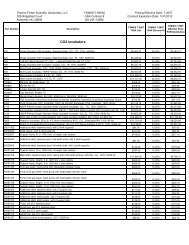Material Safety Data Sheet - Fisher Scientific
Material Safety Data Sheet - Fisher Scientific
Material Safety Data Sheet - Fisher Scientific
You also want an ePaper? Increase the reach of your titles
YUMPU automatically turns print PDFs into web optimized ePapers that Google loves.
<strong>Material</strong> <strong>Safety</strong> <strong>Data</strong> <strong>Sheet</strong><br />
Creation Date 04-May-2009 Revision Date 04-May-2009<br />
1. PRODUCT AND COMPANY IDENTIFICATION<br />
Product Name Infinity Urea (Nitrogen) Liquid<br />
Cat No. 07151967, 07156438, BU1241-20LBP, BU1241-180LBP, TD12401,<br />
TL12401, TR12421, TR12498, TY12401, UV12410040-BP<br />
Synonyms No information available.<br />
Recommended Use In vitro diagnostic<br />
Company<br />
<strong>Fisher</strong> Diagnostics<br />
A Division of <strong>Fisher</strong> <strong>Scientific</strong> Company, LLC<br />
A Subsidiary of Thermo <strong>Fisher</strong> <strong>Scientific</strong>, Inc.<br />
8365 Valley Pike<br />
Middletown, VA 22645-0307<br />
Tel: (800) 528-0494<br />
Target Organs None known.<br />
Potential Health Effects<br />
Acute Effects<br />
Principle Routes of Exposure<br />
Emergency Telephone Number<br />
Chemtrec US: (800) 424-9300<br />
Chemtrec EU: (202) 483-7616<br />
2. HAZARDS IDENTIFICATION<br />
CAUTION!<br />
Emergency Overview<br />
May cause eye, skin, and respiratory tract irritation . Low hazard for usual industrial or commercial handling. The<br />
toxicological properties have not been fully investigated.<br />
Eyes May cause irritation.<br />
Skin May cause irritation. Low hazard for usual industrial or commercial handling.<br />
Inhalation May cause irritation of respiratory tract. May be harmful if inhaled.<br />
Ingestion May be harmful if swallowed. Ingestion may cause gastrointestinal irritation, nausea, vomiting<br />
and diarrhea. Low hazard for usual industrial or commercial handling.<br />
_____________________________________________________________________________________________<br />
Page 1 / 9<br />
Revision Number 1<br />
Appearance Clear Physical State Liquid. Odor none
Thermo <strong>Fisher</strong> <strong>Scientific</strong> - Infinity Urea (Nitrogen)<br />
Revision Date 04-May-2009<br />
Liquid<br />
_____________________________________________________________________________________________<br />
Chronic Effects No information available.<br />
See Section 11 for additional Toxicological information.<br />
Aggravated Medical Conditions No information available.<br />
3. COMPOSITION/INFORMATION ON INGREDIENTS<br />
Haz/Non-haz<br />
Component CAS-No Weight %<br />
Water 7732-18-5 97.9356<br />
Tris (hydroxymethyl) aminomethane 77-86-1 0.7425<br />
1,3-Propanediol, 2-amino-2-(hydroxymethyl)-,<br />
1185-53-1 0.61<br />
hydrochloride<br />
Glucose 50-99-7 0.36<br />
Pentanedioic acid, 2-oxo-, disodium salt 305-72-6 0.143<br />
Dipotassium phosphate 7758-11-4 0.087<br />
Sodium azide 26628-22-8 0.05<br />
Disodium EDTA 139-33-3 0.037<br />
Adenosine 5'-(trihydrogen diphosphate), 2'-<br />
(dihydrogen phosphate), 5'->5'-ester with 3-<br />
(aminocarbonyl)-1-.beta.-D-ribofuranosylpyridinium<br />
hydroxide, inner salt, disodium salt<br />
24292-60-2 0.0249<br />
Albumins, blood serum 9048-46-8 0.01<br />
4. FIRST AID MEASURES<br />
Eye Contact Rinse immediately with plenty of water, also under the eyelids, for at least 15 minutes. Obtain<br />
medical attention.<br />
Skin Contact Wash off immediately with plenty of water for at least 15 minutes. Get medical attention<br />
immediately if symptoms occur.<br />
Inhalation Move to fresh air. If breathing is difficult, give oxygen. Get medical attention immediately if<br />
symptoms occur.<br />
Ingestion Do not induce vomiting. Obtain medical attention.<br />
Notes to Physician Treat symptomatically.<br />
5. FIRE-FIGHTING MEASURES<br />
Flash Point Not applicable<br />
Method No information available.<br />
Autoignition Temperature No information available.<br />
Explosion Limits<br />
Upper No data available<br />
Lower No data available<br />
Suitable Extinguishing Media Substance is nonflammable; use agent most appropriate to<br />
extinguish surrounding fire..<br />
_____________________________________________________________________________________________<br />
Page 2 / 9
Thermo <strong>Fisher</strong> <strong>Scientific</strong> - Infinity Urea (Nitrogen)<br />
Revision Date 04-May-2009<br />
Liquid<br />
_____________________________________________________________________________________________<br />
Unsuitable Extinguishing Media No information available.<br />
Hazardous Combustion Products No information available.<br />
Sensitivity to mechanical impact No information available.<br />
Sensitivity to static discharge No information available.<br />
Specific Hazards Arising from the Chemical<br />
Thermal decomposition can lead to release of irritating gases and vapors.<br />
Protective Equipment and Precautions for Firefighters<br />
As in any fire, wear self-contained breathing apparatus pressure-demand, MSHA/NIOSH (approved or equivalent) and full protective<br />
gear.<br />
NFPA Health 1<br />
6. ACCIDENTAL RELEASE MEASURES<br />
Personal Precautions Ensure adequate ventilation. Use personal protective equipment. Avoid contact with skin, eyes<br />
and clothing.<br />
Environmental Precautions Should not be released into the environment.<br />
Methods for Containment and Clean<br />
Up<br />
Soak up with inert absorbent material. Keep in suitable and closed containers for disposal. Do<br />
not flush down the drain. Sodium azide may react with plumbing systems to form highly<br />
explosive compounds.<br />
7. HANDLING AND STORAGE<br />
Handling Ensure adequate ventilation. Wear personal protective equipment. Avoid contact with skin,<br />
eyes and clothing. Do not breathe vapors or spray mist. Do not flush down the drain. Sodium<br />
azide may react with plumbing systems to form highly explosive compounds.<br />
Storage Keep container tightly closed in a dry and well-ventilated place. Keep away from direct sunlight.<br />
Keep at temperatures between 2° and 8 °C.<br />
8. EXPOSURE CONTROLS / PERSONAL PROTECTION<br />
Engineering Measures Ensure adequate ventilation, especially in confined areas. Ensure that eyewash stations and<br />
safety showers are close to the workstation location.<br />
Exposure Guidelines<br />
Component ACGIH TLV OSHA PEL NIOSH IDLH<br />
Sodium azide = 0.11 ppm Ceiling hydrazoic acid<br />
vapor<br />
= 0.29 mg/m 3 Ceiling NaN3<br />
Prevent or reduce skin absorption<br />
= 0.1 ppm Ceiling HN3<br />
= 0.3 mg/m 3 Ceiling NaN3<br />
= 0.3 mg/m 3 Ceiling NaN3<br />
= 0.1 ppm Ceiling HN3<br />
Component Quebec Mexico OEL (TWA) Ontario TWAEV<br />
Sodium azide = 0.11 ppm Ceiling<br />
= 0.3 mg/m 3 Ceiling<br />
Flammability 0<br />
= 0.1 ppm CEV<br />
= 0.26 mg/m 3 CEV<br />
_____________________________________________________________________________________________<br />
Page 3 / 9<br />
Instability 0<br />
Physical hazards N/A
Thermo <strong>Fisher</strong> <strong>Scientific</strong> - Infinity Urea (Nitrogen)<br />
Revision Date 04-May-2009<br />
Liquid<br />
_____________________________________________________________________________________________<br />
NIOSH IDLH: Immediately Dangerous to Life or Health<br />
Personal Protective Equipment<br />
Eye/face Protection Wear appropriate protective eyeglasses or chemical safety goggles as described by OSHA's<br />
eye and face protection regulations in 29 CFR 1910.133 or European Standard EN166<br />
Skin and body protection Wear appropriate protective gloves and clothing to prevent skin exposure<br />
Respiratory Protection Follow the OSHA respirator regulations found in 29 CFR 1910.134 or European Standard EN<br />
149. Use a NIOSH/MSHA or European Standard EN 149 approved respirator if exposure limits<br />
are exceeded or if irritation or other symptoms are experienced.<br />
9. PHYSICAL AND CHEMICAL PROPERTIES<br />
Physical State Liquid<br />
Appearance Clear<br />
Odor none<br />
Odor Threshold No information available.<br />
pH 8.4 - 8.6 (@ 19 - 22°C )<br />
Vapor Pressure No information available.<br />
Vapor Density No information available.<br />
Viscosity No information available.<br />
Boiling Point/Range Not applicable<br />
Melting Point/Range No information available.<br />
Decomposition temperature °C No information available.<br />
Flash Point Not applicable<br />
Evaporation Rate No information available.<br />
Specific Gravity No information available.<br />
Solubility completely miscible<br />
log Pow No data available<br />
10. STABILITY AND REACTIVITY<br />
Stability Stable under normal conditions.<br />
Conditions to Avoid Incompatible products. Excess heat.<br />
Incompatible <strong>Material</strong>s Strong oxidizing agents<br />
Hazardous Decomposition Products Carbon monoxide (CO), Carbon dioxide (CO2), Nitrogen oxides<br />
(NOx)<br />
Hazardous Polymerization Hazardous polymerization does not occur<br />
Hazardous Reactions . Do not flush down the drain. Sodium azide may react with plumbing<br />
systems to form highly explosive compounds.<br />
Acute Toxicity<br />
11. TOXICOLOGICAL INFORMATION<br />
Product Information No acute toxicity information is available for this product<br />
_____________________________________________________________________________________________<br />
Page 4 / 9
Thermo <strong>Fisher</strong> <strong>Scientific</strong> - Infinity Urea (Nitrogen)<br />
Revision Date 04-May-2009<br />
Liquid<br />
_____________________________________________________________________________________________<br />
Component Information<br />
Component LD50 Oral LD50 Dermal LC50 Inhalation<br />
Water > 90 mL/kg Oral LD50 Rat > 90 mL/kg Oral LD50 Rat > 90 mL/kg Oral LD50 Rat<br />
Tris (hydroxymethyl) aminomethane = 5900 mg/kg Oral LD50 Rat = 5900 mg/kg Oral LD50 Rat = 5900 mg/kg Oral LD50 Rat<br />
Glucose = 25800 mg/kg Oral LD50 Rat = 25800 mg/kg Oral LD50 Rat = 25800 mg/kg Oral LD50 Rat<br />
Dipotassium phosphate 8 g/kg (rat) Not listed Not listed<br />
Sodium azide = 50 mg/kg Dermal LD50 Rat<br />
= 27 mg/kg Oral LD50 Rat<br />
= 20 mg/kg Dermal LD50 Rabbit<br />
= 50 mg/kg Dermal LD50 Rat<br />
= 20 mg/kg Dermal LD50 Rabbit<br />
= 27 mg/kg Oral LD50 Rat<br />
= 50 mg/kg Dermal LD50 Rat<br />
= 50 mg/kg Dermal LD50 Rat<br />
= 27 mg/kg Oral LD50 Rat<br />
= 20 mg/kg Dermal LD50 Rabbit<br />
= 50 mg/kg Dermal LD50 Rat<br />
Disodium EDTA 2000 g/kg ( Rat ) Not listed Not listed<br />
Irritation No information available.<br />
Toxicologically Synergistic<br />
Products<br />
Chronic Toxicity<br />
No information available.<br />
Carcinogenicity There are no known carcinogenic chemicals in this product<br />
Component ACGIH IARC NTP OSHA Mexico<br />
Sodium azide A4 - Not Classifiable as<br />
a Human Carcinogen<br />
Not listed Not listed Not listed Not listed<br />
ACGIH: (American Conference of Governmental Industrial Hygienists)<br />
A1 - Known Human Carcinogen<br />
A2 - Suspected Human Carcinogen<br />
A3 - Animal Carcinogen<br />
ACGIH: (American Conference of Governmental Industrial Hygienists)<br />
Sensitization No information available.<br />
Mutagenic Effects No information available.<br />
Reproductive Effects No information available.<br />
Developmental Effects No information available.<br />
Teratogenicity No information available.<br />
Other Adverse Effects The toxicological properties have not been fully investigated.. See actual entry in RTECS for<br />
complete information.<br />
Endocrine Disruptor Information No information available<br />
Ecotoxicity<br />
.<br />
12. ECOLOGICAL INFORMATION<br />
_____________________________________________________________________________________________<br />
Page 5 / 9
Thermo <strong>Fisher</strong> <strong>Scientific</strong> - Infinity Urea (Nitrogen)<br />
Revision Date 04-May-2009<br />
Liquid<br />
_____________________________________________________________________________________________<br />
Component Freshwater Algae Freshwater Fish Microtox Water Flea<br />
Sodium azide Not listed = 0.7 mg/L LC50 Lepomis<br />
macrochirus 96 h<br />
= 0.8 mg/L LC50<br />
Oncorhynchus mykiss 96 h<br />
= 5.46 mg/L LC50<br />
Pimephales promelas 96 h<br />
flow-through<br />
Not listed Not listed<br />
Disodium EDTA Not listed LC50= 159 mg/L Lepomis<br />
macrochirus 96 h<br />
LC50= 320 mg/L Poecilia<br />
reticulata 96 h<br />
EC50 = 56 mg/L 8 h Not listed<br />
Persistence and Degradability No information available<br />
Bioaccumulation/ Accumulation No information available<br />
Mobility No information available<br />
13. DISPOSAL CONSIDERATIONS<br />
Waste Disposal Methods Chemical waste generators must determine whether a discarded chemical is classified as a<br />
hazardous waste. Chemical waste generators must also consult local, regional, and national<br />
hazardous waste regulations to ensure complete and accurate classification<br />
DOT Not regulated<br />
TDG Not regulated<br />
IATA Not regulated<br />
IMDG/IMO Not regulated<br />
14. TRANSPORT INFORMATION<br />
15. REGULATORY INFORMATION<br />
All of the components in the product are on the following Inventory lists: All of the components in the product are on the following<br />
Inventory lists:<br />
International Inventories<br />
Component TSCA DSL NDSL EINECS ELINCS NLP PICCS ENCS AICS CHINA KECL<br />
_____________________________________________________________________________________________<br />
Page 6 / 9
Thermo <strong>Fisher</strong> <strong>Scientific</strong> - Infinity Urea (Nitrogen)<br />
Revision Date 04-May-2009<br />
Liquid<br />
_____________________________________________________________________________________________<br />
Water Present Present - - - Present - Present Present KE-<br />
35400<br />
Tris (hydroxymethyl)<br />
aminomethane<br />
1,3-Propanediol, 2-amino-2-<br />
(hydroxymethyl)-,<br />
hydrochloride<br />
Present Present - 201-064-<br />
4<br />
- Present 2-318 Present Present KE-<br />
01403<br />
Present Present - - - Present - Present Present KE-<br />
34819<br />
Glucose Present Present - - - Present 8-46 Present Present KE-<br />
17727<br />
Pentanedioic acid, 2-oxo-, - X - 206-167disodium<br />
salt<br />
8<br />
Dipotassium phosphate Present Present - 231-834-<br />
5<br />
Sodium azide Present Present - 247-852-<br />
1<br />
Disodium EDTA Present X - 205-358-<br />
3<br />
Adenosine 5'-(trihydrogen<br />
diphosphate), 2'-(dihydrogen<br />
phosphate), 5'->5'-ester with<br />
3-(aminocarbonyl)-1-.beta.-Dribofuranosylpyridinium<br />
hydroxide, inner salt, disodium<br />
salt<br />
- - - 246-129-<br />
8<br />
- - - X - -<br />
- Present 1-452 Present Present KE-<br />
12167<br />
- Present 1-482 Present Present KE-<br />
31357<br />
- X X X X KE-<br />
13651<br />
X<br />
- - X - X -<br />
Albumins, blood serum XU Present - - - Present - Present Present KE-05-<br />
0011<br />
Legend:<br />
X - Listed<br />
E - Indicates a substance that is the subject of a Section 5(e) Consent order under TSCA.<br />
F - Indicates a substance that is the subject of a Section 5(f) Rule under TSCA.<br />
N - Indicates a polymeric substance containing no free-radical initiator in its inventory name but is considered to cover the designated<br />
polymer made with any free-radical initiator regardless of the amount used.<br />
P - Indicates a commenced PMN substance<br />
R - Indicates a substance that is the subject of a Section 6 risk management rule under TSCA.<br />
S - Indicates a substance that is identified in a proposed or final Significant New Use Rule<br />
T - Indicates a substance that is the subject of a Section 4 test rule under TSCA.<br />
XU - Indicates a substance exempt from reporting under the Inventory Update Rule, i.e. Partial Updating of the TSCA Inventory <strong>Data</strong> Base<br />
Production and Site Reports (40 CFR 710(B).<br />
Y1 - Indicates an exempt polymer that has a number-average molecular weight of 1,000 or greater.<br />
Y2 - Indicates an exempt polymer that is a polyester and is made only from reactants included in a specified list of low concern reactants that<br />
comprises one of the eligibility criteria for the exemption rule.<br />
U.S. Federal Regulations<br />
TSCA 12(b) Not applicable<br />
SARA 313<br />
_____________________________________________________________________________________________<br />
Page 7 / 9
Thermo <strong>Fisher</strong> <strong>Scientific</strong> - Infinity Urea (Nitrogen)<br />
Revision Date 04-May-2009<br />
Liquid<br />
_____________________________________________________________________________________________<br />
Component CAS-No Weight % SARA 313 - Threshold<br />
Values %<br />
Sodium azide 26628-22-8 0.05 = 1.0 % de minimis<br />
concentration<br />
SARA 311/312 Hazardous Categorization<br />
Acute Health Hazard No<br />
Chronic Health Hazard No<br />
Fire Hazard No<br />
Sudden Release of Pressure Hazard No<br />
Reactive Hazard No<br />
Clean Water Act<br />
Not applicable<br />
Clean Air Act<br />
Not applicable<br />
OSHA<br />
Not applicable<br />
CERCLA<br />
This material, as supplied, contains one or more substances regulated as a hazardous substance under the Comprehensive<br />
Environmental Response Compensation and Liability Act (CERCLA) (40 CFR 302)<br />
Component Hazardous Substances RQs CERCLA EHS RQs<br />
= 1000 lb final RQ<br />
= 454 kg final RQ<br />
= 1000 lb EPCRA RQ<br />
Sodium azide<br />
California Proposition 65<br />
This product does not contain any Proposition 65 chemicals.<br />
State Right-to-Know<br />
Component Massachusetts New Jersey Pennsylvania Illinois Rhode Island<br />
Sodium azide Extraordinarily<br />
hazardous<br />
sn 1684 Environmental hazard - Toxic<br />
U.S. Department of Transportation<br />
Reportable Quantity (RQ): Y<br />
DOT Marine Pollutant N<br />
DOT Severe Marine Pollutant N<br />
U.S. Department of Homeland Security<br />
This product does not contain any DHS chemicals.<br />
Other International Regulations<br />
Mexico - Grade No information available<br />
Canada<br />
This product has been classified in accordance with the hazard criteria of the Controlled Products Regulations (CPR) and the<br />
MSDS contains all the information required by the CPR.<br />
_____________________________________________________________________________________________<br />
Page 8 / 9
Thermo <strong>Fisher</strong> <strong>Scientific</strong> - Infinity Urea (Nitrogen)<br />
Revision Date 04-May-2009<br />
Liquid<br />
_____________________________________________________________________________________________<br />
WHMIS Hazard Class<br />
Non-controlled<br />
Prepared By Regulatory Affairs<br />
Thermo <strong>Fisher</strong> <strong>Scientific</strong><br />
Tel: (412) 490-8932<br />
Creation Date 04-May-2009<br />
Print Date 04-May-2009<br />
16. OTHER INFORMATION<br />
Revision Summary "***", and red text indicates revision<br />
Disclaimer<br />
The information provided on this <strong>Safety</strong> <strong>Data</strong> <strong>Sheet</strong> is correct to the best of our knowledge, information and belief at the date<br />
of its publication. The information given is designed only as a guide for safe handling, use, processing, storage,<br />
transportation, disposal and release and is not to be considered as a warranty or quality specification. The information<br />
relates only to the specific material designated and may not be valid for such material used in combination with any other<br />
material or in any process, unless specified in the text.<br />
End of MSDS<br />
_____________________________________________________________________________________________<br />
Page 9 / 9


